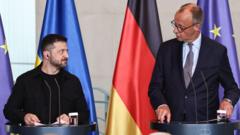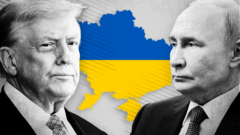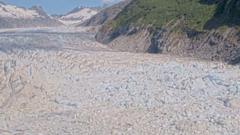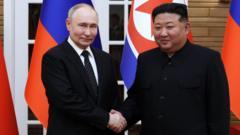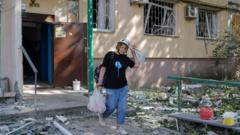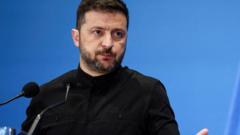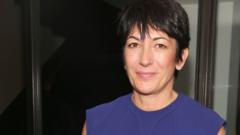The upcoming summit in Anchorage marks a critical moment in US-Russia relations as tensions from the Ukraine conflict continue to escalate.
**Trump and Putin Set to Meet in Alaska Amidst Ongoing Ukraine War**

**Trump and Putin Set to Meet in Alaska Amidst Ongoing Ukraine War**
US and Russia leaders aim for ceasefire discussions on August 15.
As the war in Ukraine rages on, Presidents Donald Trump and Vladimir Putin are preparing for a significant meeting in Anchorage, Alaska, scheduled for Friday, August 15. Trump announced the summit a week in advance, coinciding with his ultimatum to Russia for a ceasefire agreement or face heightened US sanctions. Despite three previous rounds of negotiations occurring earlier this summer — all initiated by Trump — peace remains elusive, prompting this high-stakes dialogue.
The decision to meet in Alaska carries historical significance, stemming from the US purchase of the territory from Russia in 1867. Russian presidential aide Yuri Ushakov highlighted the geographical proximity of the two nations, noting that the Bering Strait serves as their only natural barrier. He hinted that Alaska was a logical choice for such a pivotal conversation. Anchorage, the state's largest city, will serve as the venue, specifically at Joint Base Elmendorf-Richardson, which is crucial for US military operations in the Arctic.
The impetus for the meeting is Trump’s ongoing push to end the war. As a candidate, he promised a swift resolution if elected. Since the conflict escalated with Russia's invasion in 2022, Trump has expressed disappointment in Putin’s actions and has outlined a deadline for a ceasefire — a deadline that led directly to this meeting. The White House has downplayed expectations, framing the gathering as an opportunity for Trump to gauge Putin’s stance on the war, rather than a platform for immediate resolution.
Ukrainian President Volodymyr Zelensky is not slated to attend, despite ongoing discussions about his potential inclusion. Trump indicated he could reach out to Zelensky immediately after the summit, and the two leaders are set to converse virtually prior to the Alaska meeting, alongside other European leaders. Zelensky has been clear that he will not accept any agreements reached without Ukraine's involvement, stating that resolutions lacking their input would be ineffective.
While both nations express a desire for an end to the fighting, they remain at an impasse concerning territorial disputes. Trump has voiced intentions to recover land for Ukraine while simultaneously hinting at the need for concessions regarding territorial boundaries. Ukraine firmly opposes Russian control of any seized regions, particularly Crimea. Conversely, Putin stands firm on demands that align more closely with Russia's strategic interests, including Ukraine's military and diplomatic alignment.
This upcoming meeting thus represents not only a potential path toward peace but also highlights the broader complexities of international negotiations, where divergent objectives frequently clash. Amid economic ramifications and military tensions, the summit between Trump and Putin could reshape future diplomatic interactions and outcomes regarding Ukraine.
The decision to meet in Alaska carries historical significance, stemming from the US purchase of the territory from Russia in 1867. Russian presidential aide Yuri Ushakov highlighted the geographical proximity of the two nations, noting that the Bering Strait serves as their only natural barrier. He hinted that Alaska was a logical choice for such a pivotal conversation. Anchorage, the state's largest city, will serve as the venue, specifically at Joint Base Elmendorf-Richardson, which is crucial for US military operations in the Arctic.
The impetus for the meeting is Trump’s ongoing push to end the war. As a candidate, he promised a swift resolution if elected. Since the conflict escalated with Russia's invasion in 2022, Trump has expressed disappointment in Putin’s actions and has outlined a deadline for a ceasefire — a deadline that led directly to this meeting. The White House has downplayed expectations, framing the gathering as an opportunity for Trump to gauge Putin’s stance on the war, rather than a platform for immediate resolution.
Ukrainian President Volodymyr Zelensky is not slated to attend, despite ongoing discussions about his potential inclusion. Trump indicated he could reach out to Zelensky immediately after the summit, and the two leaders are set to converse virtually prior to the Alaska meeting, alongside other European leaders. Zelensky has been clear that he will not accept any agreements reached without Ukraine's involvement, stating that resolutions lacking their input would be ineffective.
While both nations express a desire for an end to the fighting, they remain at an impasse concerning territorial disputes. Trump has voiced intentions to recover land for Ukraine while simultaneously hinting at the need for concessions regarding territorial boundaries. Ukraine firmly opposes Russian control of any seized regions, particularly Crimea. Conversely, Putin stands firm on demands that align more closely with Russia's strategic interests, including Ukraine's military and diplomatic alignment.
This upcoming meeting thus represents not only a potential path toward peace but also highlights the broader complexities of international negotiations, where divergent objectives frequently clash. Amid economic ramifications and military tensions, the summit between Trump and Putin could reshape future diplomatic interactions and outcomes regarding Ukraine.

